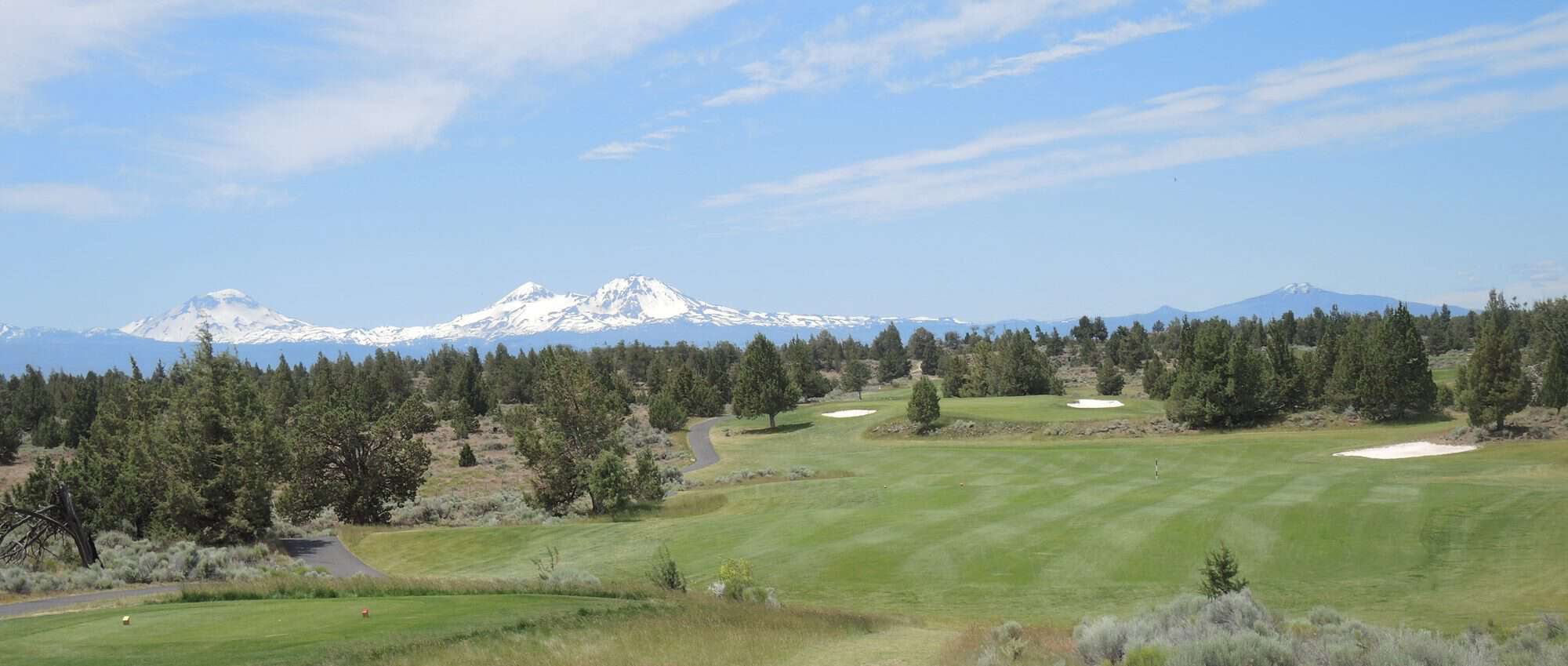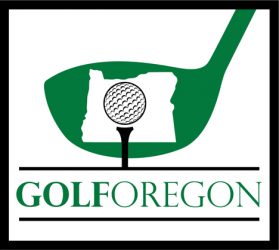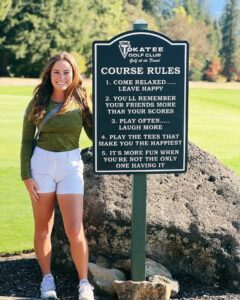I was getting a bit tired of the PGA vs LIV mess, where more attention was being paid to the competition between the organizations instead of the competition on the course. Then: I watched Rose Zhang for the first time; I read that the great Oregon-born golfer (and winner of multiple Oregon junior and women’s state championships) Gigi Stoll won her first Epson Tour event; and watched the Women’s US Open at Pebble Beach Golf Links (which was great). I found that staying in tune with professional women golfers was much more fun than watching the men.
And I wondered about the state of women in golf in Oregon. (I’ll admit that when I started looking into it, I am not sure what I was using for the definition of “state of women in golf.”)
Very Brief History of Women in Golf
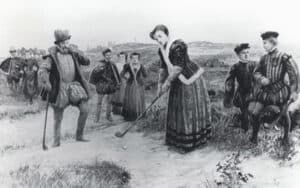
For centuries women have been subject to exclusionary and/or repressive tactics and attitudes in golf. Mary Stuart, Queen of Scotland from 1542 to 1567, was an avid golfer. During her reign, the Old Course at St Andrews was established (although some of it was built before). But after her death, golf became popular with business folks (read: businessmen), men’s sporting attire was much less restrictive than women’s (you try to hit a driver with a corset), and there was a pervasive male dominant attitude across societies. GOLF became “Gentlemen Only, Ladies Forbidden.”
This attitude against women golfers lasted well into the 20th century. Here is a 1893 quote reflective of the time., Horatio Gorton “Horace” Hutchinson, golfer, golf writer, and captain of St. Andrews Golf Club, responded with the following to an inquiry on the advisability of forming a professional ladies’ golf club:
I have read your letter about the proposed Ladies Golf Union with much interest. Let me give you the famous advice of Mr Punch (since you honour me by asking for my opinion). DON’T. My reasons? Well?
1)Women never have and never can unite to push any scheme to success. They are bound to fall out and quarrel on the smallest or no provocation; they are built that way! 2) They will never go through one Ladies’ Championship with credit. Tears will bedew, if wigs do not bestrew the green.
Constitutionally and physically women are unfitted for golf. They will never last through two rounds of a long course in a day. Nor can they hope to defy the wind and weather encountered on our best links even in spring and summer. Temperamentally, the strain will be too great for them. THE FIRST LADIES’ CHAMPIONSHIP WILL BE THE LAST, unless I and others are greatly mistaken. The LGU seems scarcely worthwhile.
[Emphasis in original. Mr. Punch was the byline of a golf humorist of the time. The LGU was formed in 1893 anyway and successfully continued until it merged with the R&A in 2017. A round of raspberries for Mr. Hutchinson.]
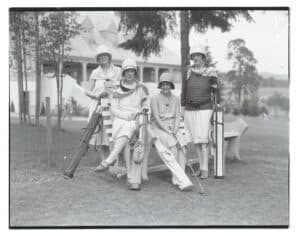
Progress for women in golf was slowly made in the late 19th and 20thcenturies: the first US Women’s Amateur was played in 1895, the American Ladies’ Golf Association was formed in 1897, the Women’s Professional Golf Association was formed in 1944, and the LPGA was established in 1950. Yet, certain clubs continued to ban women and/or women members. Augusta National Golf Club did not start admitting women until 2012. In 2019, Sports Illustrated noted that several golf clubs in Great Britain and the US still did not allow women members. Oregon, of course, was not immune: single women were not allowed to be members at Waverley Country Club until 1991. Even after women were admitted as members, some clubs failed to provide separate facilities for women and/or excluded women from playing golf during a substantial portion of tee times.
With this continued overt bias against women in golf, it is no wonder that the number of women playing golf (in the world, in the US, and in Oregon) was vastly below the number of men. Channel Signal (relying on numbers provided by the National Golf Foundation, or NGF) reported in 2012 that only 19% of golfers in America were women.
There was, however, a significant increase in women golfers during COVID. The NGF reported that between 2019 and 2022 there was a 14% increase in women golfers, with women accounting for 25% of all golfers by 2022. More importantly, the NFG reported that between 2012 and 2022, there was a 28% increase in beginning women golfers so that by 2022 41% of beginning golfers were women (and 36% of junior golfers were girls in 2022).
What is Happening in Oregon
I was unable to find any organization in Oregon that was tracking the number of women golfers in the State. The only public courses where I found any tracking where the ones owned by Portland Parks & Recreation, now managed by Kemper Sports (being the two courses at Heron Lakes, Colwood Golf Course, Eastmoreland Golf Course, and Rose City Golf Course). Unfortunately, Portland Parks only recently started keeping track and then only through responses to questionnaires (it’s self-selecting, and the number of female golfers is probably above the 12% that the survey found). NGF believes that Oregon is generally following the national pattern regarding the overall increase of women golfers, so that presently approximately 24% of on-course golfers in Oregon are women.
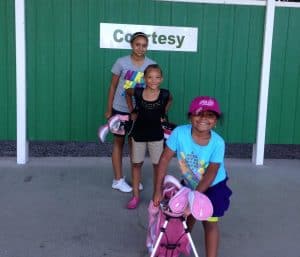
An admittedly incomplete gathering of information from other sources on female golfers in Oregon provides a mixed bag. First Tee – Portland reported a decrease in girls participating in First Tee – Portland programs, from 545 in 2019 to 235 in 2023 (this was very troubling to me as by all reports First Tee – Portland has a great program; I was not able to get from First Tee if the percentage of girls participating dropped or if the drop in numbers for girls was reflective of a drop in number of total participants). Over the past 4 years, Oregon School Activities Association (OSAA), which oversees high school golf competition in Oregon, has seen an 8.6% growth in the number of high school girls on golf teams in the state (from 970 in 2018 – 2019 to 1054 in 2022 – 2023), but the relative number of girls compared to all high school golfers has stayed pretty much the same at 37% and the amount of increase in the number of boys on teams was greater during that period at 22% (from 1464 in 2018 – 2019 to 1790 in 2022 – 2023). The Oregon Golf Association reports that the percentage of its membership that are female has stayed very steady over the past several years at about 19%. The Oregon Chapter of the PGA (or OPGA) reported that the percentage of women OPGA professionals in Oregon went from 3% (or 13 total) in 2015 to 4% (or 19 total) in 2023 (so, pretty small). Right now, there appears to be only one head pro in all of Oregon who is a woman: Kennedy Swann Bodiford at Tokatee. (I note that Melinda Murry Drummond is the head of instruction at Top Golf in Hillsboro.) There is a smattering of women in assistant pro or teaching positions at courses and clubs, but as the OPGA numbers show, it is very few.
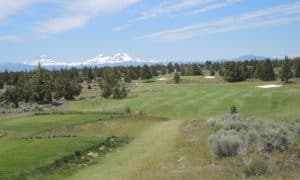
On the other hand, certain courses in Oregon have reported a material growth in participation by girls and women in golf. Ocean Dunes Golf Course in Florence reported that its women’s club has grown 75% over the past four years (OK, the total now is about 35, but the rate of growth in a small town is impressive). Juniper Golf Course in Redmond has seen the number of it’s regular women’s players increase by about 30% over the past 5 to 7 years (although the number of girls at its pee-wee camp has stayed about the same). Stone Ridge Golf Club in Southern Oregon has seen the percentage of women playing at its course increase from 0 to 20% in the past four years. The percentage of girls participating in junior clinics at Stone Ridge has also grown over the past four years.
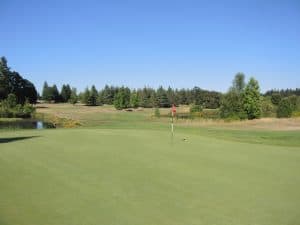
RedTail Golf Center, in the Portland metro area, probably has the largest instruction program in the state (measured by number of instructors, number of classes, and/or number of participants). It has seen the number of participants in its Intro to Golf for Women increase by about 55% from 2019 to this year. The number of girls participating in RedTail’s junior camps increased by 30% over the past 5 years. And the number of women in RedTail’s three women’s clubs (two 9-hole clubs and one 18-hole club) have significantly increased, although the vast majority of increase has come from one 9-hole club that is afforded a shotgun start for playing. The number of its members in its women’s 18-hole club has stayed relatively constant.
OK, What is Going On
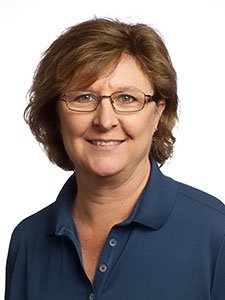
In an interview with Pacific Northwest PGA reflecting on her successful career as OGA CEO, Barb Trammell commented on the status of the women’s game at the time of her 2022 retirement:
Although the women’s game has certainly grown and expanded its reach over the years, we still have work to do with making women feel welcome at golf courses and with participating in organized events. It’s not enough just to create a dedicated women’s initiative and put it out into the community. The “build it and they will come” mentality does not work with women. We like to be invited. A personal phone call to proactively reach out with an invitation to join a group, a club or an event goes the extra mile to make someone feel included – and wanted! As far as getting more women (as well as other diverse demographics) into career positions in golf, there must be a concerted effort to provide opportunities specifically for those individuals. If you have an open position, think of ways to reach qualified candidates who are diverse and could bring a perspective to your staff that you currently do not have.
This quote is a great response to my question on the state of women golfers in Oregon. Initially, Oregon has done well in getting more girls and women to play golf. There appears to have been a significant increase in both the number of girl and women golfers in Oregon, and courses and programs in Oregon have developed a roadmap on how to succeed in getting more girls and women to play the game. Here are some examples:
- Stone Ridge changed ownership in 2019. The new management took at least the following steps to welcome and encourage girls and women to play: improving the forward tees, improving the restrooms, having golf merchandise for women, offering reduced fees on certain days for women, and changing the café menu to include wine and healthier food options.
- Juniper attributes its success to a philosophy of: making sure all women feel welcome when they are on property; treating women the same way they treat men (in a positive way); and immediately addressing all issues arising from the “archaic mentality some men retain that women should not be on the golf course.”
- RedTail attributes it’s success to many things, starting with a sizable female staff – from folks in the pro shop, to assistants in the junior camps, to pros. RedTail also carries a large amount of women’s equipment and clothing (women can help women select clubs). RedTail hosts a variety of methods for how girls and women can have an initial golf experience – from small social events that include a bit of golf, to a few holes with a pro, to classes, to camps, to lessons, to multiple clubs (and that variety then forms stepping stones for girls and women to play better and get more involved).
A lot has been written about the question of how to attract more girl and women golfers. Although a material difference is made between how to attract girls or women (the former focusing on family support, social interaction (including social media), and success recognition), the most common tip that I saw was to make the potential female golfer feel welcome and invited: get rid of the “this place is for men” vibe and spend a bit more time inviting and then welcoming the newcomer. Ms. Trammell is right, and the courses in Oregon that I mention above are providing such a welcoming atmosphere and succeeding in attracting more girls and women to play.
Ms. Trammell’s quote makes a marked distinction between getting more girls and women to play and getting more women into the profession. On the latter point, Oregon does not seem to be improving. This is shown in several different ways: the lack of an increase in female members of OPGA, the lack of an increase in female members of OGA, the relatively flat percentage of girl high school golfers from OSAA (although a good increase in numbers), and even RedTail’s experience of showing a marked increase in its 9-hole (more socially-oriented) clubs, but not its 18-hole women’s club. Although there does seem to be an increase in women business managers of golf clubs (which is great), there remains a very low number of women golf program managers, pros, and teachers.
So What; Now What
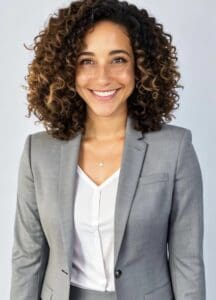
Should we care about the lack of professional women golfers in Oregon? Initially, if golf courses want to increase the number of its customers by increasing the number of girl and woman golfers (a sizable demographic), it would be beneficial to have women in positions of authority having direct interaction with customers. For example, Ashley Bogaerts, the new pro at RedTail, reported that her golf instruction classes became full with girls and women as soon as her name went out as a new instructor. Kennedy Swann Bodiford, the head pro at Tokatee, has found that women come to her from far away because the woman golfer wants a woman teacher and they can’t find one in their area.
If more women golf professionals would improve the golf business in Oregon, how could that be done? Anyone who has worked on hiring in a male-dominated field knows that hiring and retaining women is much more successful when there are women in places of authority and support (I am not saying it can’t be done, I am just saying that chances for success materially increase; note now I am suggesting that there are no less than two good business reasons to increase the number of women golf professionals in Oregon). As the number of girl and women golfers increase, how does Oregon bridge the gap and attract more women golf professionals? I was fortunate to have the opportunity to speak with three extraordinary women golfers now in Oregon about their experience in becoming successful golf professionals.
- Ashely Bogaerts was one of the highest rated high school golfers in Arizona and is now a teaching pro at RedTail. She was introduced to golf as a child when her father, an avid golfer, suggested that she and her mother take group lessons together. Ashley caught the bug and was playing in tournaments by the time she was 9. She grew as a golfer with help from the local First Tee, the Bill Dickey Scholarship Association, and the LPGA/USGA Girls’ Golf of Phoenix Future Stars program (which helped Ashley to be better on the course and prepared her for college). Ashley was awarded a golf scholarship to Texas Southern but after one year on its golf team, she found herself burnt out and took a pause from golf. Later, at the urging of her parents, she earned her LPGA Class A certification, which she used to get jobs as a golf professional, winding up instructing at RedTail. Ashley says that at all points in her golfing experience she felt she had the support and resources to do what she wanted in golf. Now as an instructor, she feels she can share the game that she loves with many.
- In 2021, Kennedy Swann Bodiford was on the team at Ole Miss that won the NCAA Golf title and then became the first woman to win the Oregon Open. She is now the only woman head pro in Oregon at Tokatee Golf Club. She started to play softball, but when her coach pushed her away from the game, she started playing golf with her dad. Before high school, she had two swing coaches who took her to the next level, and she was ready to be competitive in a strong high school district (and she was, ranked as the third best high school woman golfer in Texas). She continued to use a swing coach during high school. She started at Clemson and then transferred to Ole Miss. Her coach at Ole Miss helped her with the mental game and course management, but she points to the mentorship of older women players in helping her make the bridge to becoming a professional.
- Shelly Liddick has been an LPGA member since 1993 and has had a very successful career as a player and college coach (being named LPGA National Coach of the Year in both 2012-2013 and 2013-2014). She is now a pro at Rock Creek Country Club in the Portland metro area (where she offers lessons and clinics to the public). She was a college golfer when several people encouraged her to take the next steps to the mini-tours. During recovery for an injured shoulder, with some help from her former coach, she began teaching and coaching (and still competed). She never thought of doing anything outside of the golf business, but after experiencing a variety of positions in golf, she sees a variety of opportunities for women wanting to be in the golf business.
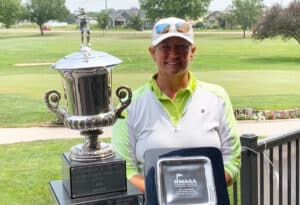
Shelly Liddick winning Nebraska Women’s Amateur Golf Association’s 2021 Golfer of the Year
What I took away from these three accomplished women at various stages of their careers is that there are different paths to becoming a golf professional and you don’t have to be a playing pro to be in a position of authority. Each of these women have inherent drive, desire, and talent. All received encouragement, mentoring, and/or support at several points along their journeys, whether it was from individuals or organizations. Some of the organizations are listed above, but they also include, to name a few: LPGA Teaching Education Program, PGA Works, and the PGA PGM Associate Program.
To expand on Ms. Trammell’s quote, to get more women in the golf profession, there should be a concerted effort to provide opportunities and support. At all points in the growth of a girl/woman golfer, provide moral support and point to programs that could provide financial and training support (and note that being a leader in the golf industry does not just mean being a playing pro). And if you manage a golf facility, recognize the economic benefit of having women in visible positions. As Ms. Trammell stated, there needs to be a concerted effort by the golf industry (and I would suggest players as well) to improve on the present situation.
I want to thank all the people who were gracious enough to provide me with their valuable time as I was doing research for this article: Vincent Johnson at Portland Parks, Bob Rannow at Ocean Dunes Golf Links, Wes Gribas at RedTail, Rob Malone at Juniper Golf Course, Greg Loper at OGA, and Dominic Marconi at OPGA. And a very big thanks to Ashley Bogaerts, Kennedy Swann Bodiford, and Shelly Liddick; I was so honored to talk with each of them.
Submit your review | |
